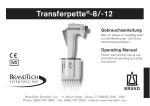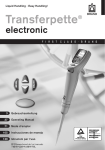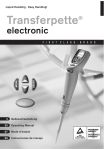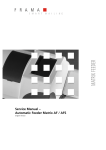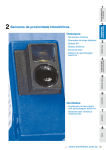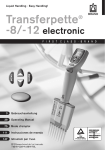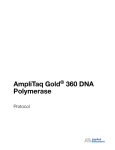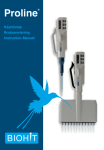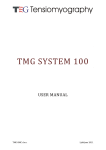Download Transferpette Multichannel Electronic User Manual 2003
Transcript
Liquid Handling · Easy Handling! Transferpette -8/-12 electronic ® F I R S T 3 Gebrauchsanleitung 35 Operating Manual 67 Mode d'emploi 99 Instrucciones de manejo C L A S S · B R A N D English Table of Contents Page Safety Instructions 36 Functions and Limitations of Use 37 Operating Exclusions 37 Operating Elements 38 The First Steps 39 Setting the Volume 40 Setting the Aspiration and Discharging Speed 41 Correct Pipetting 42 The Pipetting Programs 43 - PIP mode 44 - PIPmix mode 46 - revPIP mode 48 - Electrophoresis (GEL) mode 50 - DISP mode 52 Checking the Volume 54 Accuracy Table 55 Easy Calibration TM (adjustment) 56 Autoclaving 58 Reference Run (rEF) 58 Servicing and Cleaning 59 Disassembling the Manifold 60 Charging and Replacing the Battery 62 Battery Regeneration Function 63 Troubleshooting 64 Ordering Information · Accessories · Spare Parts 65 Repairs 66 35 Safety Instructions This instrument may sometimes be used with hazardous materials, operations, and equipment. It is beyond the scope of this manual to address all of the safety problems associated with its use in such applications. It is the responsibility of the user of this pipette to consult and establish appropriate safety and health practices and determine the applicability of regulatory limitations prior to use. ! Please read the following carefully! 1. Every user must read and understand this operating manual prior to using the pipette and observe these instructions during use. 2. Follow general instructions for hazard prevention and safety instructions; e.g. wear protective clothing, goggles and gloves. When pipetting infectious or other hazardous samples, all appropriate regulations and precautions must be followed. 3. Only use the instrument for pipetting only liquids that conform to the specifications defined in the operating exclusions and limitations (see page 37). 4. Observe all safety precautions provided by reagent manufacturers. 5. Only pipette liquids that do not react with polypropylene (PP) and polycarbonatepolybutyleneterephthalate (PC/PBT). 6. Never use force on the instrument! 7. Operate only with tips attached (see page 42). Do not lay the instrument down horizontally when the tips are attached. 8. Avoid touching the tip orifices when working with hazardous samples. 9. Always work in a way which neither endangers the user nor any other person. When emptying the tips, the sample must never spray or splatter into the surrounding area. Discharge into suitable collecting vessel. Warning! 36 10. Only press the pipetting key after ensuring that discharging the sample will not result in any danger. Only dispense liquids into a suitable collecting vessel. 11. Do not use the instrument in potentially explosive environments or with explosive samples. 12. Only use AC adapter indoors. Protect from moisture. 13. To charge the NiMH battery pack, use only the original AC adapter. 14. Do not replace the original battery pack with other battery packs, or cells. Use only original manufacturer’s replacement battery packs. 15. Confirm battery pack is completely discharged prior to disposal. Observe relevant disposal regulations for your facility. 16. Use only original manufacturer’s accessories and spare parts. Do not modify the instrument in any way, other than specifically described by the manufacturer. 17. In case of malfunction, immediately stop pipetting. Consult the “Troubleshooting” section of this manual, and contact the manufacturer if needed. Improper use of the instrument or the batteries (short circuit, mechanical damage, overheating, incorrect AC adapter, etc.) can lead to battery explosion. The Transferpette®-8/-12 electronic is a microprocessor-controlled, battery-operated pistonstroke multichannel pipette which uses the airdisplacement principle for the pipetting of aqueous solutions with an average density and viscosity. Limitations of use The Transferpette ®-8/-12 electronic is intended for the pipetting of liquids within the following limitations: - Temperature of both the instrument and solution should be between 15 °C to 40 °C (59 °F to 104 °F) for the instrument and the reagent. Consult the manufacturer for use in temperatures outside of this range. - Vapor pressure up to 500 mbar - Viscosity: 260 mPa s (260 cps) Battery and power supply unit specifications English Functions and Limitations of Use When the instrument is used properly, the sample only comes into contact with the tips and not with the Transferpette ®-8/-12 electronic. Operating exclusions Never use the instrument for pipetting liquids, that react adversely with polypropylene (PP: shaft) or polycarbonate/polybutyleneterephthalate (PC/ PBT: handgrip). Avoid reactive vapors due to the danger of corrosion. Do not use use aggressive cleaning agents (e.g., bleach) to clean the instrument. Distilled water or a mild soap solution is recommended. The pipetting of highly dense or viscous liquids as well as the pipetting of liquids, which react with polypropylene (PP) or polycarbonate/polybutyleneterephthalate (PC/PBT) is only possible within limitations. Battery Nickel-metal hydride battery, 3 cylindrical individual cells with size AAA, 3.6 V, 700 mAh Power supply unit Output voltage 6.5 V DC, 200 mA 37 Operating Elements The Transferpette®-8/-12 electronic is a microprocessorcontrolled, battery-operated, piston-stroke multichannel pipette, which has been optimized for ergonomic operation and ease of use. Charging jack Display Program keys Battery compartment Pipetting key Tip ejection key Finger rest The Transferpette ®-8/-12 electronic rests easily and ergonomically in your hand. The finger rest is height adjustable with a screw, which allows fine-tuning of the hand position for effortless operation of the function buttons. Handgrip Manifold Key Functions Up key (+) Nose cone Menu selection key Entry confirmation/ Power 'On'* Down key (-) Pipetting key *) The instrument is activated by pressing the ENTER key. After pressing the pipetting key next, the instrument is ready for pipetting. The Transferpette ®-8/-12 electronic shuts off 10 min after the last instrument operation (Auto-Power-Off). 38 The First Steps English Is everything in the package? Confirm that your package includes: Transferpette®-8 or -12 electronic pipette, battery, power supply unit with battery charging cable, 1 Tip-Box SL filled, 1 Tip-Rack for refill, 1 instrument stand, 1 reagent reservoir, silicone oil, operating manual and 1 set of V-rings made of Viton ®. Initializing the Transferpette ®-8/-12 electronic 1. Insert the a) Open the cover of the battery compartment. A b) Insure that the plug for the battery is firmly connected to the pipette. Insert the battery. B battery c) Replace the battery compartment. 2. Activate the instrument The Transferpette ®-8/-12 electronic automatically requests a reference run directly after the battery is inserted. After the pipetting key is pressed, the reference run is carried out and the instrument is now ready for pipetting. The display shows the standard factory setting (pipetting mode/PIP); and the nominal volume (for example, 100.0 µl). Default aspiration and discharging speeds are at maximum. The adjustment of volume and speed is described on the following pages. C 1x Pipetting mode Battery charge indicator Up arrow, indicating aspiration Volume setting 39 Setting the Volume The volume for the Transferpette®-8/-12 electronic is set at the factory to the nominal volume of the instrument and can be changed quickly and easily. What to do How to do it 1. Activate volume setting Keys to press Press one of the arrow keys to activate volume selection. 'VOL' blinks. 2. Change the volume Reduce volume Increase volume Press the up arrow key (+) to increase the volume. Holding the arrow key down accellerates the rate of change. 'VOL' continues to blink. 3. Confirm volume Press the ENTER key. The display now shows the new volume setting, in this case, 102.8 µl in the PIP mode. setting Important: 40 Press the down arrow key (-) to reduce the volume. Holding the arrow key down accellerates the rate of change. 'VOL' continues to blink. – + 1x By pressing the MENU key any procedure can be cancelled! The display then moves to the next setting or back to the initial display (depending on actual selection.) Display readout Setting the Aspiration and Discharging Speed What to do How to do it Keys to press English The aspiration and discharging speeds can be individually adjusted. When the menu is called up, the last speed setting is shown. Five speed levels are available. Display readout Setting the aspiration speed 1. Bring up the menu 2. Change the aspiration speed 3. Confirm speed level Press the MENU key once to bring up the aspiration speed menu. 'Speed' blinks. 1x + Press one of the arrow keys (+/-) to select the desired speed (in this case, level 5). 'Speed' continues to blink. – Press the ENTER key. The display returns to the start position for the current pipetting mode (in this case, the standard PIP mode). 1x Setting the discharging speed 1. Bring up the menu 2. Change the discharging speed 3. Confirm speed level Press the MENU key twice to bring up the discharging speed menu. 'Speed' blinks. Press one of the arrow keys (+/-) to select the desired speed (in this case, level 2). 'Speed' continues to blink. Press the ENTER key. The display returns to the start position for the current pipetting mode (in this case, the standard PIP mode). 2x + – 1x 41 with the Transferpette ®-8/-12 electronic Correct Pipetting The volume is set at the factory to the nominal volume for the Transferpette ®-8/-12 electronic and can be changed quickly and easily. See page 40. Quick start in the standard pipetting mode 1. Attach the tips 2. Aspirate liquid Note: Ensure the tips are seated firmly and seal against the nose cones. Hold the pipette vertically and immerse the tips 2 to 3 mm into the liquid. Press the pipetting key to aspirate the liquid into the tips. The arrow in the display points upwards to indicate the aspiration of liquid. 1x Note: 3. Discharge liquid To avoid the intake of air, leave the tips immersed into the liquid for approx. 1 sec. After the liquid has been aspirated, the arrow in the display points downwards to indicate discharging. Hold the pipette at an angle between 30º and 45º, place the tips against the vessel wall. Press the pipetting key again and the liquid is completely discharged including automatic blowout. Afterwards wipe pipette tips against the vessel wall. 1x 4. Eject tips 42 Hold the pipette shaft over a suitable disposal container and press the tip ejection key. Tip ejection key English The Pipetting Programs Page 1. Normal Pipetting PIP Mode 44 Standard program. A previously set volume is aspirated into the pipette tips and then discharged. 2. Mixing of Samples PIPmix Mode 46 Program for mixing liquids. The sample is repeatedly aspirated and discharged. 3. Reverse Pipetting revPIP Mode 48 Program especially for pipetting liquids with a high viscosity or vapor pressure, or that tend to foam. 4. Pipetting for Electrophoresis GEL Mode 50 Program for loading electrophoresis gels. A predefined sample volume is aspirated at high, adjustable speed and then slowly discharged. 5. Dispensing DISP Mode 52 Program for dispensing liquids. An aspirated volume is dispensed repeatedly in defined steps. 43 The Programs · Settings and Use PIP Mode The standard program – a previously set volume is aspirated and then discharged. Volume and speed adjustments are described on pages 40 and 41. What to do 1. Bring up the menu Press the MENU key three times to bring up the mode selection menu. 'Mode' blinks. 2. Select PIP mode Use one of the arrow keys to scroll through the modes until 'PIP' appears. 'Mode' continues to blink. 3. Confirm PIP mode Press the ENTER key. The display now shows 'blo' for blow-out. 4. Prepare for pipetting ➞ 5. Aspirate liquid 44 How to do it Press the pipetting key once to move the pistons into the start position. The arrow in the display points upwards (aspiration). Keys to press 3x 1x 1x Press the pipetting key once to aspirate the liquid. 1x Display readout English PIP Mode What to do 6. Discharge liquid ➞ 7. Start blow-out? How to do it Press the pipetting key once to discharge the liquid. The arrow in the display points downwards (discharge). Keys to press Display readout 1x No action required! When pipetting in the PIP mode the blow-out function is performed automatically. Start blow-out manually The blow-out function can, if necessary, be initiated manually at any time. 1. Bring up the blow-out function 2. Start blow-out Press the ENTER key. The display shows 'blo' for blow-out. Press the pipetting key once to initiate the blowout process. The display moves back to the start position of the selected pipetting mode. 1x 1x Note: To accomplish the blow-out, the pistons move to the lowest position. The user must be certain that any residual liquid is discharged safely. If the pipetting key is pressed and held, the pistons will be maintained at their lowest position to avert an accidental aspiration of liquid. When the key is released, the pistons return to the start position. 45 The Programs · Settings and Use PIPmix Mode Program for mixing of liquids. The sample is repeatedly aspirated and discharged. Volume and speed adjustments are described on pages 40 and 41. What to do 1. Bring up the menu 2. Select PIPmix mode 3. Confirm PIPmix mode 4. Prepare for pipetting ➞ 5. Aspirate liquid 46 How to do it Press the MENU key three times to bring up the mode selection menu. 'Mode' blinks. Keys to press 3x Scroll through the modes using the arrow keys until 'PIPmix' appears. 'Mode' continues to blink. Press the ENTER key. The Display now shows 'blo' for blow-out. Press the pipetting key once to move the pistons into the start position. The arrow in the display points upwards (aspiration). 1x 1x Press the pipetting key once to aspirate the liquid. 1x Display readout English PIPmix Mode What to do 6. Discharge liquid in the PIPmix mode ➞ ➞ 7. End pipetting How to do it Press and hold the pipetting key and the liquid is alternately aspirated and discharged. The display shows the up arrow for aspiration and the down arrow for discharging and the number of cycles. Display readout press and hold Press the pipetting key once and the liquid is discharged and the blowout function initiated. After the discharge of the residual liquid (blow-out), the display moves back to the start position. Note: Keys to press 1x The display shows a maximum of 19 cycles. 47 The Programs · Settings and Use revPIP Mode Program for pipetting of liquids with high viscosity, vapor pressure or that tend to foam. Volume and speed adjustments are described on pages 40 and 41. What to do 1. Bring up the menu 2. Select revPIP mode 3. Confirm revPIP mode 4. Prepare for pipetting Press the MENU key three times to bring up the mode selection menu. 'Mode' blinks. 6. Discharge liquid in the revPIP mode ➞ 48 Keys to press 3x Scroll through the modes using the arrow keys until 'revPIP' appears. 'Mode' continues to blink. Press the ENTER key. The Display now shows 'blo' for blow-out. Press the pipetting key once to move the pistons into the start position. The arrow in the display points upwards (aspiration). 1x 1x Press the pipetting key once. The volume aspirated will be a little bit more than set. ➞ 5. Aspirate liquid How to do it 1x To discharge the measured amount of liquid, press the pipetting key once. The arrow in the display points downwards (discharge). Some liquid will remain in the tips. 1x Display readout What to do How to do it 7. Repeat aspiration ➞ of liquid in revPIP mode 8. Initiate blow-out Press the pipetting key again and the set volume is aspirated into the tips. Press the pipetting key again and the volume is discharged again, and so on... Keys to press English revPIPMode Display readout 1x Press the ENTER key after the last pipetting operation. The display shows 'blo' for blow-out. 1x Press the pipetting key once to initiate the blowout process. The residual liquid is discharged. 1x 9. End pipetting After the residual liquid is discharged (blow-out), the display moves back to the start position. 49 The Programs · Settings and Use Electrophoresis (GEL) Mode Program for loading electrophoresis gels. A predefined sample volume is aspirated into the pipette tips with high adjustable speed and then slowly discharged. Volume and speed adjustment is described on pages 40 and 41. What to do 1. Bring up the menu How to do it Press the MENU key three times to bring up the mode selection menu. 'Mode' blinks. 2. Select GEL mode Scroll through the modes using the arrow keys until 'GEL' appears. 'Mode' continues to blink. 3. Confirm GEL mode Press the ENTER key. The Display now shows 'blo' for blow-out. 4. Prepare for pipetting ➞ 5. Aspirate liquid Press the pipetting key once to move the pistons into the start position. The arrow in the display points upwards (aspiration). 3x 1x 1x Press the pipetting key once. The set volume is aspirated into the tips. 1x Aspirate a larger volume In order to aspirate a larger volume than was set (up to a max. of 110% of the nominal volume), press and hold the pipetting key until the desired volume has been aspirated. The display shows a rhombus. 50 Keys to press press and hold Display readout What to do 6. Discharge liquid in the GEL mode How to do it ➞ Press the pipetting key once to discharge the liquid. The rhombus is shown in the display. The liquid is discharged very slowly. Keys to press English Electrophoresis (GEL) Mode Display readout 1x Interrupt discharging To interrupt discharging, press the pipetting key again. The display shows the volume discharged prior to interruption. 7. Initiate blow-out 1x Press the ENTER key after the last pipetting operation. The display shows 'blo' for blow-out. 1x Press the pipetting key once to initiate the blow-out process. The residual liquid is discharged. 1x 8. End pipetting After the residual liquid is discharged (blow-out), the display moves back to the start position. Note: The GEL mode operates using a very slow discharge speed to prevent swirling of the samples. To assure optimal discharging into a gel, this discharge speed is fixed for the GEL mode. This speed is significantly slower than level 1 and cannot be selected individually. 51 The Programs · Settings and Use DISP Mode Program for discharging an aspirated liquid in pre-defined steps. The volume aspirated will be a little bit more than actually needed. Speed adjustment is described on page 41. What to do 1. Bring up the menu 2. Select DISP mode 3. Confirm DISP mode 4. Prepare for dispensing 5. Set dispensing step volume 6. Confirm dispensing step volume 52 How to do it Press the MENU key three times to bring ap the mode selection menu. 'Mode' blinks. Keys to press 3x Scroll through the modes using the arrow keys until 'DISP' appears. 'Mode' continues to blink. Press the ENTER key. The Display now shows 'blo' for blow-out. Press the pipetting key once to move the pistons into the start position. The arrow in the display points upwards (aspiration). Press the arrow keys (+/-) to set the volume. Holding the arrow key down accellerates the rate of change. 'VOL' blinks. Press the ENTER key. The display now shows the new volume setting for the dispensing steps and the max. number of steps. 'Steps' blinks. 1x 1x + – 1x Display readout What to do How to do it 7. Set the number of steps Keys to press + English DISP Mode Display readout Press the arrow keys (+/-) to set the number of steps. 'Steps' continues to blink. – 8. Confirm the number of steps 9. Aspirate Press the ENTER key. The display now shows the number of steps that has been set. 1x Press the pipetting key once to aspirate the liquid. ➞ liquid 1x 10. Dispense liquid ➞ 11. Initiate blow-out 12. End dispensing Each time the pipetting key is pressed one dispensing step is performed. The arrow in the display points downwards (discharge). The display shows the number of dispensing steps left. Press the ENTER key after the last dispensing step. The display shows 'blo' for blow-out. Press the pipetting key next once to initiate the blow-out process (see also p. 51). 1x 1x After the residual liquid is discharged (blow-out), the display moves back to the start position. 53 Checking the Volume Depending on use, we recommend inspection of the instrument every 3 to 12 months. The cycle can, however, be adjusted to individual requirements. The gravimetric testing of the pipette volume is performed according to the following steps and is in accordance with DIN EN ISO 8655, Part 6. 1. Set nominal volume See page 40 for procedure. 2. Condition the pipette Condition the pipette before testing by using pipette tips to aspirate and discharge the test liquid (distilled H2O) five times. After this, discard the pipette tips. 3. Carry out the test a) Attach new pipette tips and pre-rinse one time with test liquid. b) Aspirate liquid and pipette it into the weighing vessel. Note: Each individual channel must be tested separately. c) Weigh the pipetted quantity with an analytical balance. Please follow the operating manual instructions from the balance manufacturer. d) Calculate the volume, taking the temperature into account. e) 3-10 pipettings and weighings per channel in three volume ranges (100 %, 50 %, 10 %) are recommended for statistical analysis. Calculation (for nominal volume) xi = Weighing results n = Number of weighings Mean value x = Σ xi n Accuracy* A% = V – V0 · 100 V0 Z = Correction factor (for example 1.0029 µl/mg at 20 °C, 1013 hPa) Mean volume V = x · Z Standard Deviation s=Z· Σ (x i – x ) 2 n–1 Coefficient of Variation* CV% = 100 s V V0 = Nominal volume *) = Calculation of accuracy (A %) and variation coefficient (CV %): A % and CV % are calculated according to the formulas for statistical control. 54 Accuracy Table ! 20 °C Ex English Final test values related to the nominal capacity (maximum volume) indicated on the instrument, obtained when instrument and distilled water are equilibrated at ambient temperature (20 °C/68 °F) and with smooth operation. According to DIN EN ISO 8655. Accuracy tolerances for the Transferpette ®-8/-12 electronic Volume range µl 30 - 300 10 - 100 2 - 20 Volume step µl A* ≤±% CV** ≤% Increment µl 300 0.6 0.25 0.2 150 1.2 0.4 30 3.0 1.2 100 0.8 0.25 50 1.6 0.4 10 4.0 1.5 20 1.0 0.5 10 2.0 1.0 2 8.0 3.0 0.2 0.02 Type of tips µl 300 200 / 300 20 A* = Accuracy, CV* = Coefficient of Variation 55 Easy Calibration TM Adjustment of the Transferpette ®-8/-12 electronic The calibration mode 'CAL' Adjustment The instrument should be set to either the nominal volume (for example 100 µl for a 100 µl pipette) or a specific test volume, in the standard pipetting mode (PIP). See page 40 for procedures. What to do 1. Bring up the CAL mode 2. Activate the CAL mode 3. Confirm CAL mode 56 How to do it Press and hold the MENU key (> 3 sec) until CAL appears. The display reads 'off'. 'CAL' blinks. Keys to press 1x >3s Press one of the arrow buttons to activate the CAL mode. The display changes from 'off' to 'on'. 'CAL' continues to blink. Press the ENTER key. The display now shows the set pipetting volume. 'CAL' blinks. 4. Set the volume Use the arrow keys (+/-) to set the volume, which was previously determined and tested. 'CAL' blinks. 5. Confirm volume Press the ENTER key. The display shows the tested and corrected volume. The CAL symbol is continously displayed to confirm that an adjustment has been made. 1x 1x Display readout English Easy Calibration TM Revert to factory default settings The continually displayed CAL symbol refers to a previously made adjustment. What to do How to do it 1. Bring up the CAL mode 2. Deactivate CAL mode 3. Revert to factory setting Important: Note: Press and hold the MENU key (> 3 sec) until CAL appears. The display reads 'on'. 'CAL' blinks. Keys to press Display readout 1x >3s Press one of the arrow keys to deactivate the CAL mode. The display changes from 'on' to 'off'. 'CAL' continues to blink. Press the ENTER key. The CAL symbol disappears. The instrument has now been reverted to factory default setting. 1x When the Transferpette®-8/-12 electronic is adjusted, a volume offset is performed, which means that the volume is changed across the entire volume range of the pipette by the same amount. It is recommend that the adjustment be performed at 50% of the nominal volume. The instrument is permanently adjusted for watery solutions, but it can also be set for solutions with varying density, viscosity and temperature. The Transferpette ®-8/-12 electronic can be adjusted in every mode, with the exception of the GEL mode. 57 Autoclaving The manifold (M) of the Transferpette ®-8/-12 electronic (highlighted in picture) can be autoclaved at 121 °C at a pressure of 2 bar for 20 minutes according to DIN. Note: The handgrip can not be autoclaved! 1. Eject the pipette tips. 2. Unscrew the manifold from the grip. 3. Autoclave the complete manifold without any further disassembling. 4. Allow the manifold to completely cool and dry. 5. Screw the manifold into the grip. 6. Perform a reference run (rEF). Note: The effectiveness of the autoclaving must be verified by the user. If the manifold is autoclaved frequently, then the pistons should be lubricate with the supplied silicone oil in order to provide smoother movement. M Reference run (rEF) A manual reference run must be completed each time the manifold is reattached to the handle. The reference run is needed to assure secure connection of the pistons. What to do 1. Bring up rEF mode Simoultaneously press the MENU and the ENTER key to activate the rEF mode. 2. Perform the Press the pipetting key once to start the reference run. A noise can be heard, clearly indicating the function is being performed. reference run Note: 58 How to do it Keys to press Display readout 1x 1x After the reference run, the display automatically returns to the previous program. Servicing and Cleaning Note: The changing of the V-rings/O-rings on the individual nose cones is described in detail in the instructions enclosed with the spare part. English The three main components of the manifold can be easily separated and disassembled for servicing, cleaning or replacing parts. The procedures are illustrated on the following pages. M The main components of the manifold A Piston unit with piston support bar [ I ] and pistons inserted in this unit, which can be screwed out individually for cleaning or replacement. B Nose cone assembly with nose cone support bar [ II ] and central guide rod (Z), which is attached to this, and the nose cones and seals, which can be screwed out individually for cleaning or replacement. C Manifold housing, which is connected to the manifold housing cover [ III ] of the piston unit with two turn-lock fasteners. III Servicing In order to assure proper functioning, the Transferpette® -8/-12 electronic should be serviced and cleaned at regular intervals. I A What is to be inspected? 1. Inspect nose cones and seals for damage. 2. Inspect the pistons and seals for contamination and damage. 3. Test the sealing of the instrument. To do this aspirate a sample, and then hold the instrument in a vertical position for about 10 sec. If a drop forms at the tip orifices, see the troubleshooting guide on page 64. Z II B Cleaning Instructions 1. Clean single nose cones, pistons and nose cone support bar/piston support bar (these components only) with soap solution or isopropyl alcohol, afterwards rince with distilled water. 2. Let these parts dry and cool down completely. Residual moisture in the nose cones may result in a loss of accuracy. 3. Lubricate the piston with a very thin coating of the silicone oil supplied. For the central guide rod (Z) only use the recommended fluorstatic grease! 5. After assembling the device, performe the reference run (rEF). C 59 Disassembling the Manifold Removing of nose cones and seals for cleaning or replacing 1. Unscrew the manifold from the handle. 2. Turn both closures of the B A manifold housing cover 90° and slide off the housing. ➞ 3. Push the mounting tool on the nose cone and unscrew it (Fig. A and B). ➞ 4. Push the piston unit down to the bottom. Remove the seal and inspect it and clean or replace if necessary (Fig. C). Push the mounting tool on and unscrew the single nose cone Note: The seal (Abb. C) will either remain inside the nose cone or will stay on the piston after the nose cone is removed. D C 6. If required, lubricate the piston lightly with the supplied silicone oil. 8. Reassemble the manifold ➞ with its flat side facing upward. Use the mounting tool to mount and tighten the cleaned or new nose cone (Fig. D). and check the instrument for tightness (s. page 59 „Servicing“). Remove the seal for cleaning or replacement 60 ➞ 7. Push the seal on the piston Insert the seal and screw in the cleaned or new nose cone Disassembling the Manifold English Removing of pistons for cleaning or replacing 1. Unscrew the manifold from the handle. A B 2. Turn both closures of the manifold housing cover 90° and slide off the housing. ➞ ➞ ➞ 3. Remove both outer Phillips screws on the nose cone assembly. Z ➞ ➞ Attention: Do not loosen the central guide rod (Z)! 4. Pull the piston and nose Separate the piston and nose cone assembly C Screw off the piston nut D cone assembly apart and separate (Fig. A). 5. Place the mounting tool on the piston nut and screw off the piston nut (Fig. B). 6. Remove the piston nut and ➞ piston and screw on the piston nut and tighten with the mounting tool (Fig. D). ➞ pull out the piston (Fig. C). 7. Insert the cleaned or new 8. Reassemble the manifold and check the instrument for tightness (s. page 59 „Servicing“). Remove the piston nut and the piston Insert the cleaned or new piston and tighten the piston nut 61 Charging and Replacing the Battery A fully charged battery allows approx. eight hours of continuous pipetting of liquids with a viscosity and density similar to water. Important! Before charging the battery ensure that the AC adapter is compatible with the line voltage in the laboratory. Do not charge the device in an explosive environment. The battery can only be charged inside the Transferpette ®-8/-12 electronic. Charge the battery a) Insert the charging cable plug for the AC adapter into the jack at the top of the Transferpette®-8/-12 electronic; charging starts automatically b) During the charging, the bars for the battery capacity run continually from the bottom to the top. The battery is fully charged, when the bars in the display have stopped moving. Pipetting during charging? During charging, you can continue to work with the Transferpette®-8/-12 electronic. If the battery is fully discharged, it will take a few minutes until a certain minimum charge capacity is available, which is needed to operate the instrument safely. Note: The last settings are stored in the memory of the instrument. If the battery is fully discharged or the battery is changed, these settings are saved. Replace the battery a) Open the battery compartment cover. Remove the battery and pull the plug gently out of the socket. A b) Insert the plug of the new battery into the socket and insert the battery. B c) Put the battery compartment cover in place again and close it. C Remove the battery from the instrument, when it is not to be used for longer periods. 62 Charging and Replacing the Battery Note: a) After the battery is inserted, the display shows the full capacity indicator with a blinking frame, the instrument does not recognize the charging status right now. After 3.5 hours of charging time – safe full charging of the battery – the frame stops blinking. English Battery display after inserting a battery After inserting a battery always charge 3.5 hours! Battery regeneration function (Refresh function) In order to extend the service life and to optimize performance of the battery, the Transferpette ®-8/-12 electronic has a regeneration function (refresh function). This program provides a controlled full discharge and recharging of the battery. To optimize the battery performance, this refresh function should be used periodically. Perform the refresh function a) Insert the plug for the AC adapter into the jack on the top of the Transferpette®-8/-12 electronic. b) Press and hold the lower arrow key (>3 sec). During the discharging process, the capacity bars for the battery indicator run continually from the top to the bottom. 1x >3s c) After the controlled discharge (up to 3 hours), the charging process (3.5 hours) is started automatically. During charging, the capacity bars run continually from the bottom to the top. Interrupting the discharge-charge cycle Press any button to end the program. The instrument switches automatically to the standard pipette mode (PIP) and to the nominal volume and the normal charging process is started automatically, see page 62. Removing the plug for the AC adapter also ends the program. 63 Troubleshooting If an error occurs, the instrument display shows “Err” and the error number is also shown. The instrument will now only react to the ENTER key. Pressing the ENTER key will attempt to restart the instrument. Therefore, a reference run is automatically requested. Problem Possible cause Corrective action Battery discharged or faulty Charge battery for at least 5 min without operating, then only operate with charging cable attached until battery is recharged. Replace battery if needed. Faulty electronic component Send in the instrument for repair. Instrument does not react Faulty electronic component Send in the instrument for repair. Instrument does not react Unpredicted program error Confirm error by pressing the ENTER key. The instrument is reinitialized. Instrument does not react No battery inserted Insert battery. Battery is defective Replace battery. Faulty electronic component Send in the instrument for repair. Display is dark Electrostatic discharge Remove and insert the battery. Tip drips/ instrument not sealed or volume error Improper tip Only use quality tips. Tip is not properly seated Press tip in firmly Piston seal is contaminated or damaged Clean the instrument/ replace the seal. Piston movement is limited Unscrew the manifold and move the metal part in the middle by hand. Instrument does not react Liquid is not aspirated or there is a loud motor noise 64 Error message Ordering Information · Accessories · Spare Parts Volume 2 - 20 µl 10 - 100 µl 30 - 300 µl Cat. No. 27054 02 27054 08 27054 12 English Transferpette ®-8 electronic incl. AC adapter (110V/50-60 Hz) Transferpette ®-12 electronic incl. AC adapter (110V/50-60 Hz) Volume 2 - 20 µl 10 - 100 µl 30 - 300 µl Cat. No. 27054 22 27054 28 27054 32 Quality pipette tips PLASTIBRAND® racked in Tip-Box SL AC adapters Cat. No. Volume 7053 52 Spare parts Transferpette -8/-12 electronic Parts will differ slightly depending on nominal volume of instrument. (Fig. shows spare parts for Transferpette ®-8/-12 electronic 10-100 µl.) Cat. No. 7022 02 0.1 - 20 µl 96 0.5 - 20 µl 96 7022 04 2 - 200 µl 96 7022 06 5 - 300 µl 96 7022 08 Repl. battery ® Total tips per pack Silicone oil Fluorstatic gr. Cat. No. Cat. No. Cat. No. 7055 00 7036 77 7036 78 A D Seal B Volume C Piston Nose cone V-Ring/O-Ring A B C D 2 - 20 µl 7056 70 7056 80 7034 13 7033 41 10 - 100 µl 7056 72 7056 82 7034 91 7033 44 30 - 300 µl 7056 74 7056 84 7034 91 7033 46 65 Repairs If a problem cannot be fixed by following the troubleshooting guide, or by replacing one of the parts listed on page 65, then the instrument must be sent in for repair. Please note: for the safety of courriers and our employees, and to avoid violation of federal and local laws, only clean instruments free of any chemical, biological or radioactive hazards can be inspected and repaired! Sending in for repair Important: Transporting of hazardous materials without a permit ist a violation of federal law. BrandTech Scientific, Inc. will not accept instruments that are not appropriately cleaned and decontaminated. Therefore contact BrandTech Scientific, Inc. and obtain return authorization before sending your instrument for service. Note: 66 No warranty claims can be considered if repairs other than those described have been made or attempted.




































